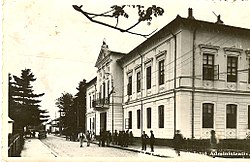Gorj
Demographics
At the 2011 census, the county had a population of 334,238 and its population density was 59.66/km (154.5/sq mi).
At the 2021 census, Gorj County had a population of 314,685.
| Year | County population |
|---|---|
| 1948 | 280,524 |
| 1956 | 293,031 |
| 1966 | 298,382 |
| 1977 | 348,521 |
| 1992 | 400,100 |
| 2002 | 387,308 |
| 2011 | 334,238 |
| 2021 | 314,685 |
Geography
Gorj County has a total area of 5,602 km (2,163 sq mi).
The North side of the county consists of various mountains from the Southern Carpathians group. In the West there are the Vâlcan Mountains, and in the East there are the Parâng Mountains and the Negoveanu Mountains. The two groups are split by the Jiu River.
To the South, the heights decrease through the hills to a high plain at the Western end of the Wallachian Plain.
The main river, which collects all the smaller rivers, is the Jiu River; its tributaries include the Tismana, Gilort, and Motru rivers.
Neighbours
- Vâlcea County to the east.
- Mehedinți County and Caraș-Severin County to the west.
- Hunedoara County to the north.
- Dolj County to the south.
Economy
The predominant industries in the county are:
- Mining equipment industry.
- Food and beverages industry.
- Textile industry.
- Mechanical components industry.
- Glass industry.
- Wood industry.
In the North of the county, coal is extracted near Motru and Rovinari. There are two big thermo electrical power plants at Rovinari and Turceni, and some hydro-electrical power plants. The county is the biggest electricity producer in Romania, with 36% of the country's electricity.
Due to the decrease in mining activity, the county has one of the highest unemployment levels in the country.
Tourism

The main tourist destinations are:
- The city and the area around Târgu Jiu:
- The Constantin Brâncuși sculptural ensemble;
- Tismana Monastery.
- The Parâng Mountains.
- Polovragi Monastery.
Politics
The Gorj County Council, renewed at the 2020 local elections, consists of 32 counsellors, with the following party composition:
| Party | Seats | Current County Council | ||||||||||||||||
|---|---|---|---|---|---|---|---|---|---|---|---|---|---|---|---|---|---|---|
| Social Democratic Party (PSD) | 16 | |||||||||||||||||
| National Liberal Party (PNL) | 11 | |||||||||||||||||
| People's Movement Party (PMP) | 3 | |||||||||||||||||
| PRO Romania (PRO) | 2 | |||||||||||||||||
Administrative divisions


Gorj County has 2 municipalities, 7 towns and 61 communes
- Municipalities
- Communes
- Albeni
- Alimpești
- Aninoasa
- Arcani
- Baia de Fier
- Bălănești
- Bălești
- Bărbătești
- Bengești-Ciocadia
- Berlești
- Bâlteni
- Bolboși
- Borăscu
- Brănești
- Bumbești-Pițic
- Bustuchin
- Câlnic
- Căpreni
- Cătunele
- Ciuperceni
- Crasna
- Crușeț
- Dănciulești
- Dănești
- Drăgotești
- Drăguțești
- Fărcășești
- Glogova
- Godinești
- Hurezani
- Ionești
- Jupânești
- Lelești
- Licurici
- Logrești
- Mătăsari
- Mușetești
- Negomir
- Padeș
- Peștișani
- Plopșoru
- Polovragi
- Prigoria
- Roșia de Amaradia
- Runcu
- Săcelu
- Samarinești
- Săulești
- Schela
- Scoarța
- Slivilești
- Stănești
- Stejari
- Stoina
- Țânțăreni
- Telești
- Turburea
- Turcinești
- Urdari
- Văgiulești
- Vladimir
Historical county
Județul Gorj | |
|---|---|
County (Județ) | |
 The Gorj County Prefecture building of the interwar period. | |
 | |
| Country | |
| Historic region | Oltenia |
| Capital city (Reședință de județ) | Târgu Jiu |
| Area | |
| • Total | 4,579 km (1,768 sq mi) |
| Population (1930) | |
| • Total | 206,339 |
| • Density | 45/km (120/sq mi) |
| Time zone | UTC+2 (EET) |
| • Summer (DST) | UTC+3 (EEST) |
Historically, the county was located in the southwestern part of Greater Romania, in the northern part of the historical region of Oltenia. Its capital was Târgu Jiu. The interwar county territory comprised a large part of the current Gorj County.
It was bordered to the west by Mehedinți County, to the north by the counties of Hunedoara and Sibiu, to the east by Vâlcea County, and to the south by Dolj County.
Administration

The county was originally divided into four administrative districts (plăși):
- Plasa Gilort, headquartered at Gilort
- Plasa Jiu, headquartered at Jiu
- Plasa Novaci, headquartered at Novaci
- Plasa Vulcana, headquartered at Vulcana
Subsequently, two more districts were established:
Population
According to the 1930 census data, the county population was 206,339 inhabitants, ethnically divided as follows: 97.9% Romanians, 1.7% Romanies, as well as other minorities. From the religious point of view, the population was 99.6% Eastern Orthodox, as well as other minorities.
Urban population
In 1930, the county's urban population was 13,030 inhabitants, comprising 90.0% Romanians, 4.6% Romanies, 1.1% Germans, 0.9% Hungarians, 0.8% Jews, as well as other minorities. From the religious point of view, the urban population was composed of 95.8% Eastern Orthodox, 2.2% Roman Catholic, 0.8% Jewish, as well as other minorities.
Industry
In the county capital of Târgu Jiu, there was a factory producing roof tiles as of 1931.
References
- ^ "Populaţia rezidentă după grupa de vârstă, pe județe și municipii, orașe, comune, la 1 decembrie 2021" (XLS). National Institute of Statistics.
- ^ National Institute of Statistics, "Populaţia după etnie" Archived 16 August 2009 at the Wayback Machine
- ^ National Institute of Statistics, "Populația la recensămintele din anii 1948, 1956, 1966, 1977, 1992 și 2002" Archived 22 September 2006 at the Wayback Machine
- ^ "Rezultatele finale ale alegerilor locale din 2020" (Json) (in Romanian). Autoritatea Electorală Permanentă. Retrieved 2 November 2020.
- ^ Portretul României Interbelice – Județul Gorj
- ^ H. T. Montague Bell, Near East, Limited, 1931, The Near East Year Book and Who's who: A Survey of the Affairs, Political, Economic and Social, of Yugoslavia, Roumania, Bulgaria, Greece and Turkey, p. 559

